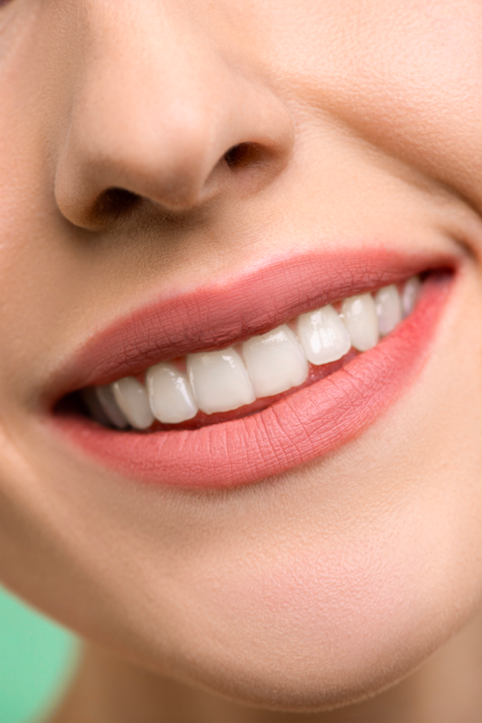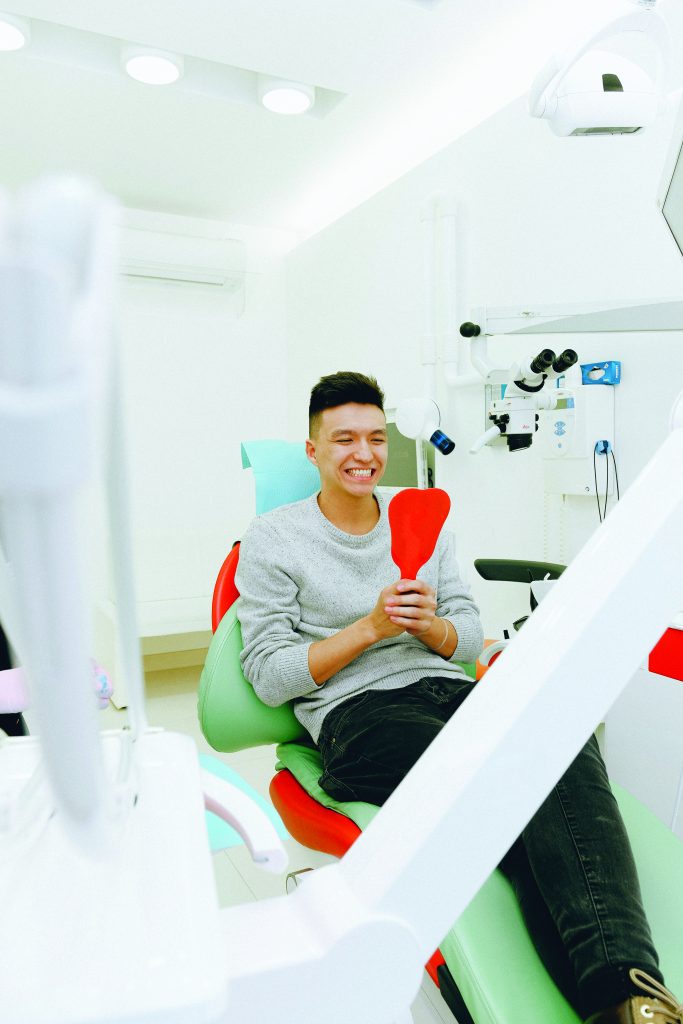Smile!
IT’S TIME TO PREEN THOSE PEARLY WHITES
RENOWNED DENTIST DR NICOLA MCARDLE ANSWERS ALL YOUR QUESTIONS AND SHARES EVERYTHING YOU NEED TO KNOW ABOUT WHITENING YOUR TEETH.

Is teeth whitening the same as polishing?
No. Routine polishing removes surface stains caused by coffee, cigarettes and red wine using strong polishing with special pastes. It can be done by your dentist or dental hygienist. Routine polishing may remove surface stains from your teeth, but it does not change the colour of your teeth. Talk to your dentist if you have deep stains on your teeth that don’t go away with routine cleaning and polishing. It could be tooth decay or another problem. Teeth whitening removes both surface and internal stains using hydrogen peroxide, a type of bleaching agent.
Why is teeth whitening so popular?
Our teeth are not perfectly white by nature, and some people feel that they could improve their smiles with brighter, whiter teeth. Stains can appear on teeth over time due to consuming certain foods and beverages. Teeth also naturally turn more yellow with age as they acquire pigmentation. Teeth whitening can dramatically enhance the appearance of one’s smile without compromising the health of their teeth. A rise in teeth whitening popularity has led to the development of a variety of bleaching solutions and techniques that have rendered it more cost-effective and enabled more predictable results with minimal side effects.

Can everyone get their teeth whitened?
A complete checkup with your dentist is recommended to determine one’s suitability for teeth whitening. Teeth whitening is ideal for patients who have healthy teeth and gums with no restorations such as fillings, crowns or veneers on their front teeth. However, one may not be a suitable candidate if they have gum disease, tooth decay or hypersensitivity. As with any dental or medical treatment, teeth whitening must be tailored to your needs. There is no ‘one size fits all. Tell your dentist what you want to achieve and any concerns you may have. Your dentist can then guide you toward the right treatment. It may be that routine professional cleaning by your dentist, together with regular brushing and flossing, will give you the ‘stain free’ natural smile that you’re looking for without the need for whitening. The dentist will examine your teeth thoroughly, check your oral health history, and decide whether tooth whitening is the treatment of choice for you.
Does the treatment work on crowns?
No. Teeth whitening only works on natural teeth. Crowns, veneers or tooth coloured fillings will not whiten. If you have any crowns, veneers or fillings in your front teeth, you may need to have these replaced after your whitening treatment to match them to your new, whiter shade.
What does the whitening process involve?
Teeth whitening is a way to improve the colour of your teeth using hydrogen peroxide (a type of bleach). It is safe and effective if carried out by a dentist or under the supervision of a dentist. It does not remove any of the surfaces of the teeth or add anything to the teeth. Once you are a suitable candidate, your dentist will work with you to identify the shade of white you wish to achieve. Impressions will then be taken of your teeth to develop customised whitening trays which you can use yourself at home. Your bespoke whitening kit will include the trays and a special whitening gel.

How long does the treatment take?
This depends on the teeth whitening procedure and kit one opts for; you may only need to use your whitening trays for one hour per day or overnight. Your dentist will advise on the particular kit you receive. Most people will use the trays for at least two weeks, but this varies from patient to patient. Teeth whitening treatment is a gradual process. It could take a number of weeks to achieve the shade you wish.
How white will my teeth get?
The shade you can achieve will depend on the shade of your teeth at the onset. Your dentist will be able to advise you on the likely outcome before you begin. With the customised kits, one has more control over their results if they do not exceed the recommended duration.
Is it painful?
One may experience some sensitivity during the whitening process. This is entirely normal and should disappear when you finish your whitening treatment. If you usually have sensitive teeth, it may be helpful to use sensitive toothpaste before and during whitening.
Is teeth whitening safe? Are there any side effects?
Teeth whitening carried out and supervised by your dentist is perfectly safe and does not harm your teeth or general health. Despite advancements in whitening materials and techniques, among the common side effects that many patients may still experience, during or after whitening are increased sensitivity to hot and cold things and, sometimes, irritation inside the mouth. These side effects usually disappear a few days after stopping treatment but can sometimes last for up to a month or so. Your dentist can help you deal with any side effects.
While several theories explain post whitening pain and sensitivity, the concentration of the whitening solution and any whitening accelerators (e.g., light activation) may be to blame. Attempting to accelerate whitening with higher bleach concentrations and/ or light (i.e., laser) activation can raise the tooth’s internal temperature, cause overly dehydrated teeth, and damage the otherwise healthy tooth structure.
All teeth whitening products containing more than 6% hydrogen peroxide are banned in Europe as they are not considered safe for patients. In addition, some so called ‘non peroxide’ bleaching products, such as sodium perborate and boric acid, damage DNA (the biological information carried in your genes), reduce fertility and harm the unborn. Always check with your dentist about any product used to whiten your teeth.
Does the light-activation/”laser” work?
Although light activation of whitening agents has existed for some time, research has demonstrated its ineffectiveness to enhance bleaching efficacy. Additionally, the science behind light activated whitening may explain why many patients experience pain after this type of whitening treatment. Lasers, lights, or another heating source, which were initially added to whitening procedures to accelerate whitening, can lead to internally heating a tooth and its dehydration, increasing the likelihood of sensitivity and pain both during and after the whitening treatment.
How long will the results last?
The effects of whitening will vary from person to person. Results may be impacted by smoking or consuming certain foods and drinks such as tea, coffee, red wine and blackcurrant.
Can one do anything to maintain a brighter smile?
After the initial application, one should have plenty of whitening gel which can be used for top ups annually or as frequently advised by your dentist. To keep one’s teeth looking their best and brightest, it is vital to maintain a good oral health routine at home, avoid smoking, eat a balanced diet, drink plenty of water, and schedule regular check-ups and polish visits to your dentist or dental hygienist to keep your teeth clean and healthy.

How safe and effective are tooth whitening products sold in shops and online?
It is often unclear exactly what these products contain, so it’s tough to know if they are safe to use or effective even. Many products bought online do not clearly state their active ingredients and often contain ingredients that are banned in the European Union (EU) on safety grounds. For example, the law states that the maximum concentration of hydrogen peroxide that can be used to whit- en teeth is 6%. This used to be a lot higher and caused uncomfortable side effects in some patients.
The EU Council Directive 2011/84/EU also states that tooth whitening can only be carried out by a dentist or under a dentist’s supervision.









